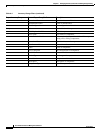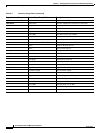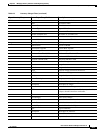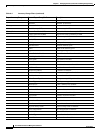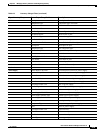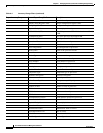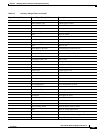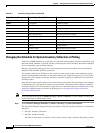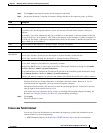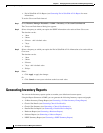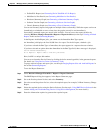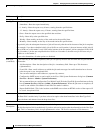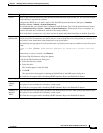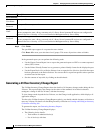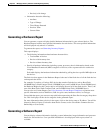
6-22
User Guide for Resource Manager Essentials 4.1
OL-11714-01
Chapter 6 Managing Inventory Collection and Polling Using Inventory
Inventory Administrative Operations
Changing the Schedule for System Inventory Collection or Polling
At the time of RME installation, system jobs are created for both Inventory collection and polling, with
their own default schedules. A periodic inventory collection job collects inventory data from all managed
devices and updates your inventory database.
Similarly, the periodic polling polls devices and updates the inventory database. You can change the
schedule of these default, periodic system jobs.
For inventory collection or polling to work, your devices must have accurate read community strings
entered. (For the detailed procedure, see the section
Adding and Troubleshooting Devices Using Device
Management.) The changes detected by inventory collection or polling, are reflected in all associated
inventory reports.
Note that the inventory poller allows you to collect inventory less often. The poller detects most changes
in managed devices, with much less impact on your network. If the poller detects changes, it initiates
inventory collection. To collect inventory or poll devices as a one-time event or for selected devices only,
create user-defined inventory collection or polling jobs (see
Creating and Editing an Inventory
Collection or Polling Job).
Note View the Permission Report (Common Services > Server > Reports) to check whether you have the
required privileges to perform these tasks.
Step 1 Select Resource Manager Essentials > Admin > Inventory > System Job Schedule.
The System Job Schedule dialog box displays the current collection or polling schedule. It is divided into
two panes:
• Job Type: Inventory Collection
• Job Type: Inventory Polling
The fields in these panes are identical. You can enter date for either collection and polling, or both.
Sys Application Software Manufacturer Software manufacturer of system application
System
SysUpTime System Up Time.
Host Name Host name of the system
Management Type Management type of system.
Modular Modularity of system.
OSI Layer Services OSI layer services of system.
System Name System name.
System Object ID System Object ID of the device.
Location System location.
Contact System contact.
Domain Name Domain name of the system.
Description Description of the system.
Table 6-3 Inventory Change Filters (continued)
Report Inventory Group Custom Report Group/Attribute Description



